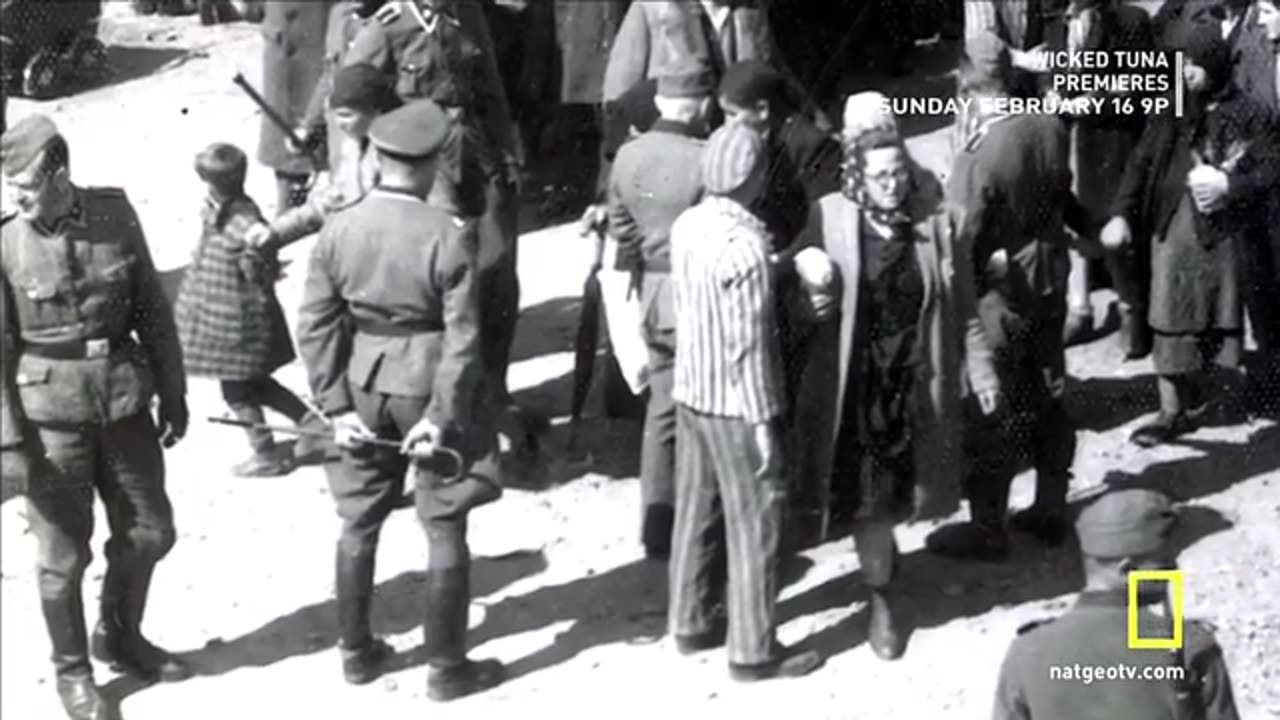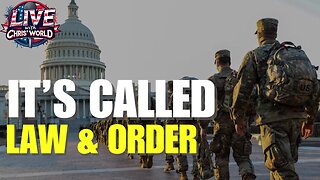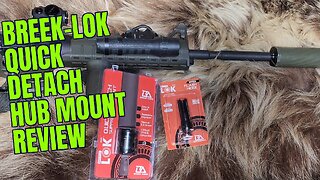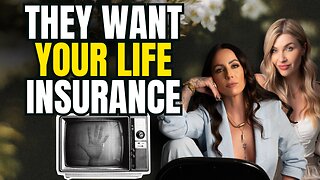Premium Only Content

The Auschwitz Albums aka NAZI SCRAPBOOKS FROM HELL - NATIONAL GEOGRAPHIC
https://www.youtube.com/watch?v=6_F9GMeydiA
You're seeing what the Nazis didn't want people to see. The whole process from arrival to death for the average Jewish person coming to Auschwitz is really just a couple of hours. I think it would be comforting to think of the killers as monsters, and this scrapbook doesn't allow that level of comfort. How do people work day and night, night and day, 24 hours a day, 7 days a week, killing other people? When you look at those pictures, they have many memories that come back. This album wasn't supposed to be here. The evidence of this crime was supposed to be erased, and it wasn't. In the summer of 1944, Auschwitz became Auschwitz. Auschwitz was not the most lethal of all the Nazi death camps, nor had it undertaken anything roughly resembling what was about to happen. In March 1944, the Germans invaded Hungary. Hungarian Jewry underwent in four months what had taken three years in Poland. The invasion was March of 1944. Ghettoization was April and early May. 437,402 Jews were shipped between the 15th of May and the 8th of July, almost all of them to Auschwitz. 437,402 Jews on 147 trains in 54 days. The arrival rate at Auschwitz was approximately 8,000 people a day, 80% of whom were killed immediately upon arrival. This imposed a Herculean task upon the killers. Gas chambers couldn't handle this number of dead, so they had to burn them in open fields using gas and using the fuel of their own bodies to destroy them. This was not for a B team, this was for an A team. 1944 was Auschwitz's moment. I would say its moment in the sun, but I mean its moment as the capital of evil. Mr. President, Your Honor. When I was deported to Auschwitz at the end of May 1944, I had no idea what Auschwitz was. There were only three independent camps. One Auschwitz, two Birkenau, three Monowitz. Each camp was independent and had its own commander and adjutant. This photo album arrived at the museum as 16 unbound leaves. His photographs are arranged very carefully, he's got themes to his pages and very carefully handwritten captions. And he's in some of the photographs. There's Karl Höcker. The donor of this album, who asked to remain anonymous, was a member of the counterintelligence corps after the war. And was tasked with the job of going into POW camps and trying to suss out who was a war criminal and who was not. He was sent to Frankfurt and told to find quarters. And he went to a bombed out building and found an apartment there that had been abandoned and he found this album in a closet. The Nazis were profoundly tempted, on the one hand, to hide what they were doing. And on the other hand, to broadcast it and to say, wow, look at us, look what we've done. And what happened from time to time is that photographs were taken and they gave a visual representation of things that I know from documents. I myself have never seen anything quite like this. This is his own sense of his personal experience during the war, what he thought was important, what presumably he wanted to remember, share with his family, what he thought was valuable. So I think this is going to be rich fodder for people to speculate on this one individual. I don't think we'll ever find anything quite like this again. Here what you see is you see the faces of the killers who were trying to unwind. Boy, we had a tough day at the office. It was hard out there. And these were men who took a certain, and I'm going to use the word deliberately, they took a professional pride in what they were doing. That doesn't make it right, it was awful, it was evil, it was horrendous, it was terrible. But it was significant. This scrapbook strikes me because I think the big question about the Holocaust is why? Why do people kill? Why were so many people able to do this in the heart of such a civilized nation? And it shows the killers as humans. This is a question that I think doesn't have answers, but this scrapbook forces us to look at the killers in a way that I think pushes our comfort level where we don't want it to go. We do know a fair bit about Karl Höcker. He was born in Engershausen, Germany. His father died in World War I and his mother struggled to raise him and his brothers and sisters. He became a bank clerk in the 1930s and joined the SS. He said in his testimony to promote his career. There's no evidence that that ever promoted his career. In the Frankfurt trial in 1963, one of the prosecutors intimated that Karl Höcker may have been sent to Auschwitz because he was so good at killing. He was so good at working at a concentration camp that Karl Höcker would be sent to kind of guide the commandant through what it was like to work at a concentration camp. So his testimony hinged on the fact whether or not he had been on the ramp and had participated in a selection process, choosing people to either go to the gas chambers or to be selected to work. And no one could prove, no one could testify that they had actually seen him there. People testified to say that he must have been there, they were sure he had been, everyone else had been, but no one could testify that they had actually seen him there. So he actually only got seven years, and so he was in prison until 1970 and then released. He went back to banking again, he took up gardening, and he died presumably of old age in the year 2000. The death of Höcker in his bed in 2000 violates our sense of justice. We would like to believe that there is a God who meets our justice in this world. It makes us wish there was a world after this world in which justice is meted out to the evil. I think when we first got the album, of course, we were really excited because we knew the possibilities for scholarship, for new information to come forward. And then the more that we learned about it, we became angry. I became angry, some of my colleagues became angry. Just because you see these guys and you know what's going on, and the fact that they don't seem to care. In my day-to-day job, I work almost exclusively with survivors and their families, people who survived this election, people who lost their families to these men. And so I'm watching Höcker shake hands with his dog and show the camera how he can make his dog sit. And I'm not hating him, his eyes aren't red, he doesn't have little horns sticking out of his forehead. I almost feel a little guilty for feeling like I kind of understand him. This is actually the picture that made us realize how special the album is, because this is the picture where we first noticed Joseph Mengele, among photographs taken at a party, most likely in the summer of 1944. And that was kind of a eureka moment, because I knew what he looked like, and I also knew that there were supposedly no photographs taken of him actually on the camp complex. So once we noticed him, that was a very big moment, because we realized that this is really something incredible, this is really something special. The interesting thing about Mengele is that he had both a PhD and an MD. So this is a very smart man that we're talking about, 32 years old, and this is what he's decided to do with his knowledge, is to put it into this kind of crime. He's standing between the current commandant and the ex-commandant of the camp. And this belies Mengele's power within the camp, by virtue of the fact that he's standing between Bayer and Hearst. Now, many people know Dr. Joseph Mengele, but Dr. Carl Klauberg was not a very nice man either. Klauberg's specialty was female sterilization. He experimented with female sterilization using acid. Though he looks like a jovial pediatrician in this photo, not a nice man either. Solihuta was an SS retreat facility. It was considered almost like a sub-camp of the Auschwitz complex. This photograph was taken upon Hooker's trip to Solihuta with the SS women. The page is actually entitled, Here There Are Blueberries, and it shows Carl Hooker handing out bowls of blueberries. And this photo shows that they've eaten all of their blueberries. The girl on the fifth to the left is pretending to cry, that there are no more blueberries for her to eat, and so she's theatrically pretending that this is an enormous tragedy, when in reality we're about 30 kilometers away from a really big tragedy, much bigger than no more blueberries. In order to deal with this material, on one sense you have to put it a little bit away. You have to keep a little bit of a distance, because if not it burns you, it sears you, it shatters you, it destroys you. But if you're not prepared to face that shattering, that destruction, you can't really understand this material. What we have at Auschwitz is the presence of absence. In other words, you feel the absence of the people who were there. You have a much greater sense at Birkenau of the killers than you do of their victims. Auschwitz replaced both. We only show you a semblance of the shadows, because the very reality of what happened could overwhelm everything, and we couldn't face it, so we show you a glimpse into the shadow. And we trust the viewer, we trust the audience, we trust all of us, to add to the glimpse that we're providing and give you a little bit more. The Auschwitz album is a unique album. It's a collection of photographs that were taken in Auschwitz at the end of May 1944 of the arrival of trains of Jews from Hungary. The photographers are two SS photographers, and they created an album with approximately 200 photographs of this arrival and the selection and the processing of this trainload of several thousand Jews that arrived at Auschwitz. There are so many chronological similarities between the Jacob album and the Hooker album. The Jacob's album was taken on May 26th and May 27th of 1944. Karl Hooker arrived at the camp to take over his new job as the adjutant to the commandant on May 25th, 1944, one day before Louis Jacob's transport arrived, one day before the photos in the Jacob album were taken. His photo album begins five days later, on June 1st. You have two albums. One shows monsters at play, and the other shows the work of the monsters. But it shows the work of the monsters not by focusing on the monsters, but by focusing on their victims. Louis Jacob was a young woman from the Transcarpathia region of Hungary, and she and her community arrived in Auschwitz in late May of 1944. They were photographed upon their arrival. She was selected to work, the vast majority of her family were not. One of the iconic photographs in the Louis Jacob album is a picture of her two younger brothers, who were killed upon arrival. Lily worked in Auschwitz, then was sent on a death march to Nordhausen, where she was liberated by the American army. She was ill with typhus and was living in an SS barrack that had been converted into a hospital. She woke up in the middle of the night and was looking for a blanket, so she opened a drawer, and in it was this photograph album. On the first page, you saw the rabbi of her town. And a number of pages later, she saw photographs of people she knew, including family, her paternal grandparents. Then she herself was in the photograph. It's really a unique document. It's the only document we have that shows us the whole process of what the Nazis were doing in Birkenau, save the gas chamber itself, up until the gas chamber. Actually, it's quite remarkable that although we have quite a bit of documentation about Auschwitz, there are hardly any photographs that we have of Jews arriving in Auschwitz, the process of what the Nazis did with the deportees. And nearly every photograph that any of us has ever seen in any museum or book or film of Jews arriving at the death camp is actually from this album. And this is therefore a rare and unique source. An increasingly difficult hope to maintain that if we understand the past, we somehow can react differently in the future. So anybody looking at this material has to both maintain a certain sense of detachment, but also behind all of this, and this is what gives the Auschwitz album, the album of the victims, gives it all the power because we must remember these were human beings. I think I was left alive for a purpose, to tell the story and the message should go, that not only for remembering our holy people, but also to make sure that this never happens again in humanity. We arrived at the train station and the cattle cars were wide open. We weren't given a ramp like animals do. We were just taken like pieces of garbage and thrown into the cattle car. Under these conditions, after three days and three nights in the middle of the night, the train stopped. We had no idea what Auschwitz was. The doors were unlocked that were locked from the outside. And men in striped suits came up and started throwing us out and said, don't take anything. You'll get it later. If somebody falls down, you're not allowed to pick them up. If a child falls down, you just have to go. And then the yelling starts. Women on one side, with the children and men on the other side, five in a row, go, run, fast. And this is accompanied by yelling, beating, shooting, and dogs. And when our family arrived to this group and were told to stop, from the whole family, I am the 16-year-old who is thrown to the right. They had a cane that has an arch like, and with that, they're throwing me back to the right. Obviously, I looked strong enough for work. And that was the last time I ever saw any member of my family. When they separated us, the people that went to the left, like I told you, were taken straight to the crematorium. And we were taken to the right and to the sauna. And told to undress. And then we are told to march into the next room. In the next room, there are little stools lined up against the wall. And we are told to sit facing the wall. And from the back, they come and they shave all our hair. All parts of the body. And we remain like shorn sheep. From us is taken away everything. Which means family pictures, clothes, jewelry, glasses. And if you can't take off your earrings fast enough, they cut it off. And then we are marched outside, and we look at each other and cannot recognize each other. Nobody recognizes each other, even sisters. And everybody is with that gray dress. And we suddenly realize these are girls from Czechoslovakia and Ukraine and Poland who are suffering there. And we start asking them, so when are we going to see our family? And they say, stupid Hungarians. Don't you know where you are? Don't you know you're in Auschwitz? Don't you know what Auschwitz is? Don't you see the chimneys? Don't you see the fire jutting out of it? That's why they're burning your people now. And we fall back in fear. And we're just shocked, but can't believe it. We will never know what it was like to be inside that gas chamber. There's a domain that forever eludes us. That's the fascination, but that's also the zone of privacy. You're seeing what the Nazis didn't want people to see. You're seeing what was happening within the gas chamber. And you don't really see that until you get up close and you look carefully at the people. You see their faces, and you see the horror that was going on at the time. I had no way of influencing these events in any way. Nor did I want to, nor did I want to. I didn't do anything to hurt anyone. Nor did I kill anyone in Auschwitz. I had never been to Birkenau, and had never participated in a selection. And so, if this is photographic evidence that Carl Hooker was on the ramp, that he participated in a selection, that proves that he lied throughout his entire trial, and really should have been sent to life or put to death for his activities at Auschwitz. It is conceivable that Hooker, upon arrival, was instructed to familiarize himself with every aspect of the camp. A man like Hooker wants to make himself useful, and wants to make himself influential. You don't want any surprises reaching you, because you don't want any surprises reaching your boss. I was asked to find if I could find consistencies with Hooker in other pictures, and compare the pictures together and see if I can come to a conclusion whether or not this person here would be consistent with Hooker. So, I drew from several photos provided to me. SS records said that Hooker was 1.75 meters tall. So, what we can do here is we can actually set up at 1.75 meters tall. This picture has a known height in it. This is a Mauser, and we know that it's 1,110 millimeters tall. Compared against the height of our known Hooker, which we know is 1.75 meters, we see that the gun comes right up to about here. What I did from there is I used measurement tools to measure each area of his body in an accurate fashion. So, you can see right here, we get 1.75. His shoulders are about 0.38 meters across from the elbow to the bottom of the palm, 0.29, and the height of the boots, about 0.42 meters. What I did is I brought all of these photos into Photoshop, and extracted them each from the original photo, and I didn't destroy any of the proportions. So, I made sure that our width was exactly the same in pixels, and our height was exactly the same in pixels. So, what we see here is actually a pretty striking similarity between these four photos. You can see that the waist is almost the exact same height in all of them. You can see that kind of right across the pelvis, they all line up. The height of the boots line up from heel to the top of the boot. The knees line up, and the top of the head lines up. They all line up extremely well. And this man's proportions seem consistent with the subject here. Identifying individuals is very difficult, and it's by no means an exact science. But within individuals, there are certain uniqueness to them. The length of the forearm, the length of the arm in general, stance and gait, size of the head, size of the inseam. These are all things that in and of themselves may not be unique, but added up totally across the entire human, that particular subject, they become unique. And so, you look at that unique kind of fingerprint aspect of his physiology, and say, okay, now is it present in the picture where he's the unknown subject, or the unknown subject is that person, Karl Hopper. When our crew was at Auschwitz, one of the things they measured were the width inside the train tracks. These train tracks are the same train tracks that were there when this picture was taken. But I wanted to make sure that our camera position, height, and angle was calibrated correctly to this photo, so I created a plane that was exactly 1.43 meters wide. And I knew that if I could move that plane forward and backward in 3D space, and it stayed between those tracks, that was calibrated correctly. And you can see right there, it's a perfect match. That gives me a visual cue compared against the height of our unknown subject. Based on everything that you can possibly think of as far as the technology is concerned, as far as measurements and science is concerned, you've really gone as far as you can really go. You've gone the extra step, and the extra step, and the extra step. It is pretty compelling evidence that the Karl Hopper from the photo album is Karl Hopper on the ramp. Doug, I respect the work that you've done. It's meticulous, it's serious, it's accurate, and it gives me new ways of looking at pictures and understanding what information they reveal. The one thing that I'm afraid of is that I'm not sure how much of a real difference it makes whether he was the ramp or not. One of the most important students of the killers was Robert J. Lifton, and he began his book, The Nazi Doctors, with a fascinating dialogue. One day, he's going out to interview a Nazi doctor, a survivor. He comes up to him and says, Bob, tell me something. Were these people monsters when they did what they did, and Lifton turns to him sharply and he said, no, no, they were people. If they were monsters, they would be uninteresting, but the fact that they were people makes it imperative that we understand them. The survivor shut back. He said, it's demonic that they were not demonic. And what strikes me as most essential about this album is it shows us that they really were people, not monsters. They were people who did a monstrous thing, people like you and like me.
-
 LIVE
LIVE
The Jimmy Dore Show
2 hours agoTrump CRACKS DOWN On Crime & Homelessness in DC! Israel Massacres Al Jazeera Journalists in Gaza!
9,959 watching -
 44:40
44:40
Katie Miller Pod
1 hour agoEpisode 1 - Vice President JD Vance | The Katie Miller Podcast
111 -
 LIVE
LIVE
LFA TV
1 day agoLFA TV ALL DAY STREAM - MONDAY 8/11/25
921 watching -
 LIVE
LIVE
RiftTV
3 hours agoBREAKING: Trump FEDERALIZES D.C. To RESTORE Law & Order | The Rift | Ryan Matta, Olivia Krolczyk + Braeden Sorbo
505 watching -
 LIVE
LIVE
megimu32
1 hour agoOTS: Breakfast Nostalgia + Blind Chocolate Cereal Showdown… LIVE! 🍫🥣
45 watching -
 LIVE
LIVE
LIVE WITH CHRIS'WORLD
8 hours agoLIVE WITH CHRIS’WORLD - It’s Called LAW & ORDER
161 watching -
 11:07
11:07
AlaskanBallistics
1 day agoBreek-Lok Quick Detach Hub Mount and Flash Hider System Review
213 -
 57:44
57:44
Donald Trump Jr.
5 hours agoExclusive Interview with Deputy Secretary of State Chris Landau | Triggered Ep266
80.6K39 -
 58:40
58:40
BonginoReport
9 hours agoModern Dating Woes & How To Resist Temptation w/ Tilly Dillehay - Hayley Caronia (Ep.109)
21.5K10 -
 53:55
53:55
The Quiet Part
8 hours agoThey Want You to Sign Over Your Life Insurance—So They Can Keep Lying to You
4.28K8